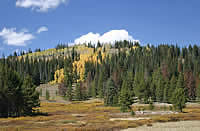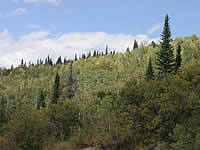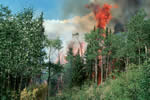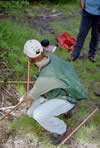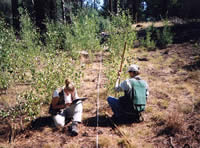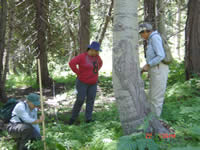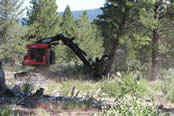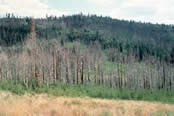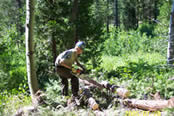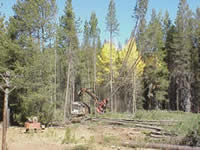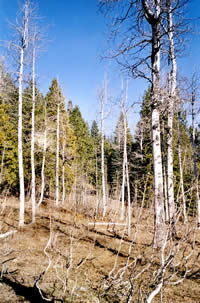USDA Forest Service Celebrating Wildflowers
|
|
|
 |
|
Managing Aspen
Aspen forests have primarily been used in the West for wildlife habitat, livestock forage, watershed protection, esthetics, and recreation. It has had limited value for wood products. These uses have not generated enough income to actively manage the aspen forest. As a result, measures have not been implemented to ensure this species is retained when other resources benefit from its presence. The suppression of forest fires has led to natural succession replacing aspen with conifers and other vegetation. Some aspen forests in the West may eventually be replaced by coniferous forest or other non-forest vegetation. Fun FactAspen groves need fire or other disturbance to stimulate sprouting and control conifers to maintain the grove.
Aspen may not persist unless it is periodically disturbed or destroyed by an event that rejuvenates the groves. The disturbance is necessary to provide for continued sprouting and the development of an uneven-aged structure of trees, including sprouts, saplings, and mature trees; and the control of other, potentially aspen-replacing species. Such stands do not produce optimum yields of wood products, esthetically may not be as attractive as mosaics of even-aged patches, and may produce inferior habitat for some species of wildlife. However, periodic disturbance, continued sprouting, and the development of the uneven-aged structure are key to maintaining the aspen forest. The density and age of the aspen is measured, before any conifers are removed from the aspen groves. Photos by Linnea Hanson. To determine whether and what actions should be taken to manage aspen, an inventory is completed of an area to determine the condition of the forest, including the aspen communities. Aspen groves are identified that may benefit from management. The inventory is completed before treating the aspen stands to document the density and age classes of the aspen and to establish monitoring locations for evaluating the effectiveness of treatments. Pictures are taken and reference tags are placed on aspen trees to provide benchmarks and reference points that may be revisited after the aspen is treated.
On the Feather River Ranger District of the Plumas National Forest, citizen scientists from the California Native Plant Society assisted in the inventory and monitoring before the conifers were removed from some aspen groves. Once, the inventory is completed, treatment options are identified, evaluated, and weighed against resource management plan objectives and concerns. A decision is made regarding the aspens that will be treated, the types of treatment, and the implementation schedule. Conifers are currently being removed by hand and also by machinery from aspen stands on many federal and private lands in the West. Often, this management approach is much safer than a prescribed fire. Land managers may decide to burn an aspen grove where there there have been no natural fires for a long time and/or where conifers and other vegetation are invading the grove. The intentional, managed use of fire is called a "prescribed burn". A manager must be careful with fire because prescribed fires can become too hot or smolder for too long a time. When this occurs, the fire can overheat the roots, kill the sprouts, and/or sterilize the soil, resulting in the aspens' death. Over time, the aspen suckers in a grove that emerge following a fire will slowly thin themselves. After 20 or 30 years, the aspen grove will have just about as many aspen trees as it did before the fire.
When conifers in the grove are removed by hand, the cut conifers are dragged to the outside of the grove. Removal of the conifers allows more sunlight to reach the ground and stimulate the aspen suckers to sprout. Removing the conifers allows more water to become available to the aspen grove and the surrounding ecosystem. Machinery is used to remove the conifers from aspen groves by picking up the logs that would be too heavy to remove by hand. These mechanically removed conifers are also removed from the grove so that the increase in sunlight and water can help the suckers sprout and grow. If the driver of the machine is careful, all the conifers can be removed without removing any of the aspen trees in the stand. Aspen suckers may take awhile to sprout after the conifers are removed from an aspen grove. Resource specialists have found that it can sometimes take three to four years before the aspen will start to sprout after conifer removal. Managing aspen involves taking advantage of the species characteristics to provide for its continuation. It can be managed for several values at once. While enhancing one value such as retaining the aspen community, other values will also benefit, such as habitat, forage, and esthetics. To retain an aspen grove, potentially competing vegetation that has become established in the grove needs to be removed, the adjoining seed sources of the invaders may also be removed, and aspen sprouting must be stimulated by the activity. The management techniques used to achieve these ends depends upon the degree of competition and on the successional stage of the existing aspen stand. |
|
| NOTE: PDF format links require the Adobe Acrobat Reader to view. | |
| top | Disclaimers | FOIA | Privacy Policy | Quality of Information | Photo Credits & Use |
Location: http://www.fs.fed.us/wildflowers/communities/aspen/managing.shtml
Last modified: Tuesday, 24-Jun-2008 21:53:18 EDT
